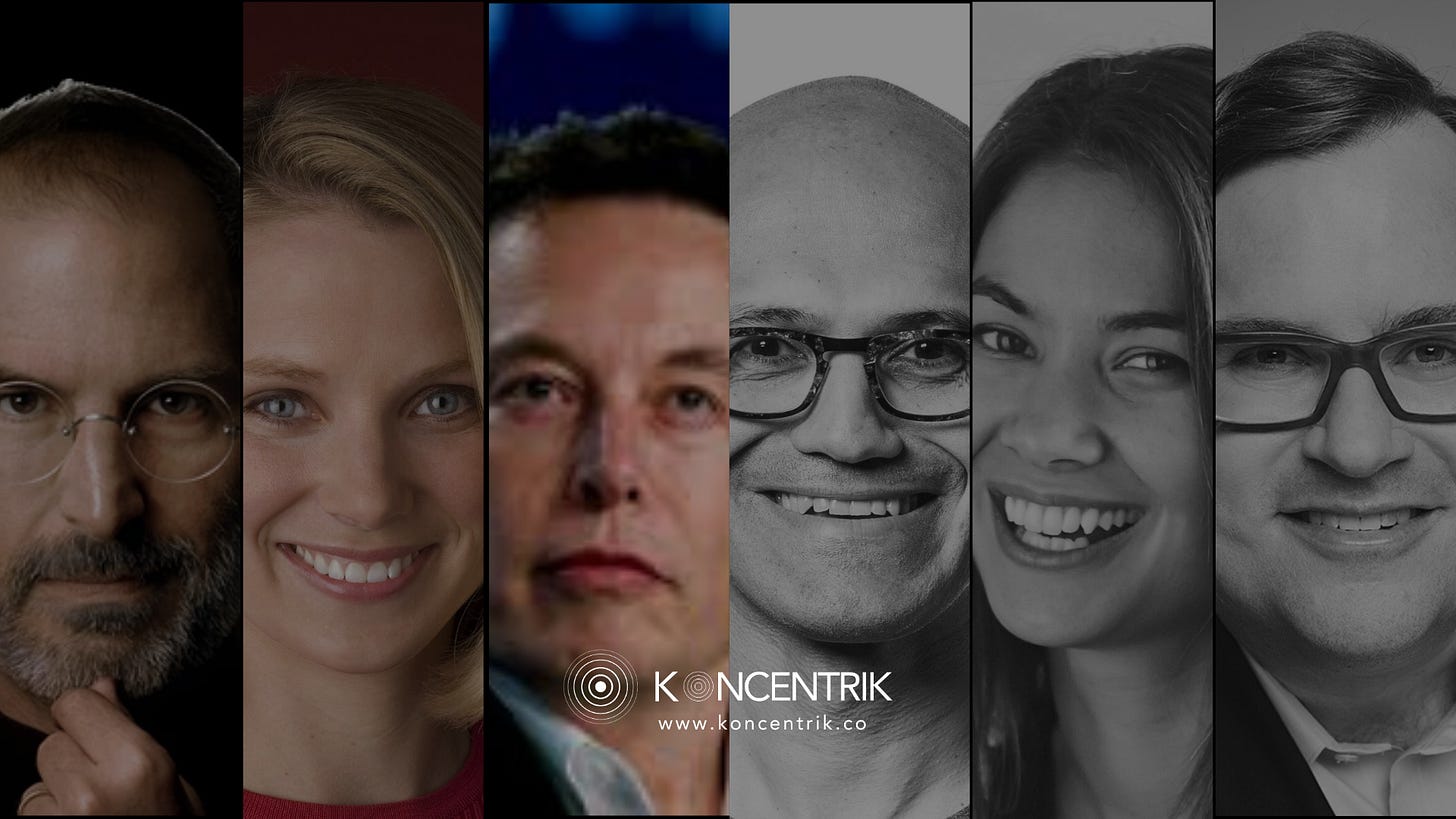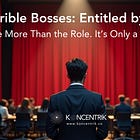The Cult of Visionary Tyrants
Why abrasive leaders seem to succeed while principled leaders tend to remain in the shadows?

Some time ago I shared about corporate leaders who seemed to become ‘entitled by their title’ - yes I even called them ‘horrible bosses’ (!). These were personal experiences across various moments of my career.
Since then I took a step back and wondered: why do we celebrate (and have to endure!) ego-maniac, a-type, aggressive, abrasive leaders?
I have a fairly, straight forward and depressing answer to this question (don’t scroll to the end just yet!), but I am going to ponder, objectively, some of the key reasons… so let’s get started, shall we?
The Paradox We Can’t Look Away From
Much of business history is filled with leaders who are celebrated as geniuses but remembered by their employees as tyrants. They are brilliant, abrasive, often egomaniacal. They bend industries to their will, build empires that reshape our daily lives, and inspire both fear and devotion.
Think Steve Jobs, the mercurial Apple co-founder whose perfectionism redefined computing and design but left scars on those closest to him. Elon Musk, the volatile autocrat who pushes employees and entire industries past breaking points in pursuit of his messianic vision. Marissa Mayer, once Silicon Valley’s golden child, later criticized for her exacting, often unforgiving leadership at Yahoo. Or Terry Gou, the iron-fisted founder of Foxconn, who turned it into the world’s largest electronics manufacturer; but at great human cost.
Let’s call them what they are: Visionary Tyrants.
But why? Why, despite their ruthlessness and abrasive style, do people follow and celebrate them?
The Landscape That Made Them
What’s interesting to note is that these leaders did not rise in a vacuum. I believe their success was turbocharged by structural forces that rewarded speed, domination, and audacity:
Economics of tech platforms: Winner-takes-all dynamics, network effects, and zero marginal cost of scaling amplified the spoils for those ruthless enough to seize them.
Globalization and deregulation: From the 1990s through 2010s, capital, supply chains, and consumer markets opened at unprecedented speed. A founder in California could dominate users in Jakarta, Paris, or São Paulo without much friction.
Geopolitical permissiveness: Governments often partnered with or subsidized these figures, desperate to harness their ambition for national gain (EV credits for Tesla, space contracts for SpaceX, export-driven incentives for Foxconn).
In short: the abrasive archetype thrived because the system rewarded ruthlessness!
Why We Follow Them Anyway
Even when the costs are obvious (burnout, toxic workplaces, ethical blind spots, societal risks) these leaders still attract legions of followers. Why?
The Mission: They frame their work as existential. Apple wasn’t just building computers; it was “changing the world.” Musk isn’t just selling cars or building rockets; he’s “saving humanity”
Proximity to Greatness: Careers are made by working in their orbit. Being yelled at by Jobs or Musk is still a résumé badge… (yes!)
Charisma and Fear: They inspire devotion while keeping teams in line through intimidation or sheer gravitational pull. Some must like it…
Cultural Memory: We glorify shock and disturbance. Abrasive leaders dominate headlines precisely because they disrupt norms.
And sadly and above all: well, the successful ones make money. A lot of it. For themselves. For shareholders. For employees (sometimes).
And being rich makes them even more powerful and entitled.
But still, I kept wondering: do they truly succeed more often? Or do we simply remember them more vividly because of the drama they generate?
The Counter-Archetype: Principled Visionaries
History (and today’s boardrooms) also give us another path. Leaders who achieve greatness without resorting to tyranny. They prove that you don’t have to be an “a**hole” to innovate at scale (excuse my French)!:
Satya Nadella (Microsoft): Transformed Microsoft’s culture from combative to collaborative, rebuilt trust with developers, and turned Azure into a global powerhouse; not through fear, but through empathy.
Melanie Perkins (Canva): Scaled Canva into a $40B design platform by prioritizing inclusivity, humility, and accessibility. A principled builder in a zero-to-one success story.
Meredith Whittaker (Signal Foundation): Left Google on principle, now leading Signal as a nonprofit, privacy-first alternative to surveillance capitalism. Shows trust can be a differentiator in the digital economy.
Reid Hoffman (LinkedIn): Built LinkedIn with a mission of economic opportunity, known for collaborative leadership and mentorship.
Let’s call them Principled Visionaries.
They may not dominate headlines as often, but they demonstrate that another way is possible!
Side by Side
Now let’s compare them side by side.
Visionary Tyrants are usually marked by egomania, perfectionism, or volatility. They lead through fear mixed with charisma, often building cults of personality around themselves. Their motivation tends to be domination, empire, or personal legacy. And their organizations often scale fast but end up fragile; deeply dependent on the founder’s will, and prone to toxicity or collapse when that will falters.
By contrast, Principled Visionaries tend to lead with empathy, inclusivity, and collaboration. Their style is rooted in trust, empowerment, and building culture first rather than enforcing loyalty. Their motivation is usually mission or purpose; creating legitimacy, serving a collective good, or stewarding an idea larger than themselves. Their organizations may grow more steadily, but they are more resilient and less dependent on one individual.
Geopolitically, the tyrant archetype thrived in the era of globalization and deregulation, when speed, domination, and borderless expansion were rewarded above all else.
The legacies are different too. Visionary Tyrants are remembered as disruptive and divisive: admired for their brilliance, feared for their cruelty. Principled Visionaries are often less loudly celebrated, but they are respected for balancing impact with principle and for building organizations that endure.
In today’s world, dominated by strongman politics and moving away from consensus based, multi-lateral relationships; it might be hard to see a path forward for Principled Leaders to succeed…
But could they be better suited in today’s sovereignty-focused, trust-conscious environment, where legitimacy and responsibility increasingly matter for long-term survival?
The Final Word
Visionary Tyrants have built extraordinary things; the devices in our pockets, the cars on our roads, the infrastructure of the digital economy. But they have also externalized enormous costs: toxic cultures, shattered lives, weakened democracies, and supply chains stained by labor abuses.
Principled Visionaries prove another way exists. Their path is harder, slower, less celebrated; but perhaps more sustainable, and more compatible with a world that increasingly values trust, sovereignty, and legitimacy.
Unfortunately the perception might just be that Visional Tyrants can help others make more money, regardless of the costs. And that’s what makes them stand out; and be remembered. But as per above, Principled Leaders can to!
But more importantly the final question is not about Jobs or Musk, Perkins or Nadella.
It’s about us: What kind of leaders are we willing to follow and what kind of leaders are we willing to become?
thanks for reading!
Damien
I am a Senior Technology Advisor who works at the intersection of AI, business transformation, and geopolitics through RebootUp (consulting) and KoncentriK(publication): what I call Technopolitics. I help leaders turn emerging tech into business impact while navigating today’s strategic and systemic risks. Get in touch to know more damien.kopp@rebootup.com


